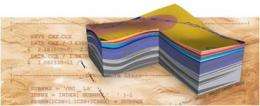A place for carbon sequestration collaboration

A new, computer-based knowledge management system will help scientists collaborate more effectively while using their preferred modeling tools to conduct more comprehensive planning for safe, long-term underground storage of greenhouse gases.
Under development at the Department of Energy's Pacific Northwest National Laboratory, the Geologic Sequestration Software Suite, or GS3, could help oversight agencies better define permitting requirements for storage projects and evaluate permit applications because it tracks the process used to study a particular site and determine its suitability. GS3 also could help evaluate the impact of having numerous storage sites within a region. Once development is complete, PNNL will make GS3 available to other researchers and institutions.
"Using GS3, we can paint the most comprehensive picture of what's happening underground and then refine our models or assumptions," said Alain Bonneville, manager of the Carbon Sequestration Initiative at PNNL. "GS3 allows us to manage and track data through the model building and simulation process in a way that allows us to also easily update that data over the lifespan of a carbon storage project, which could span 100 years."
Bonneville will present information about GS3 at the Greenhouse Gas Technology Conference on Sept. 22 in Amsterdam.
How it works
A team of computer and subsurface scientists, and engineers are working together to combine existing open-source software components with PNNL-developed tools to create a novel, flexible and dynamic framework for scientific knowledge management directed at geologic sequestration. The start-to-finish of a carbon sequestration project likely will involve generations of scientific teams over hundreds of years, from site selection, to active injection, to post-injection monitoring, to site closure. GS3 is being developed to support these teams today and ensure project continuity in the future.
Choosing an appropriate place to store greenhouse gases begins with collecting data that define the geology of the subsurface. Using those data, scientists build a 3-D image or geologic model of the subsurface and then use simulation tools to help them understand how the greenhouse gases will behave once injected underground under different scenarios.
As that understanding increases and more data is collected, the models are updated to reflect the new information. Then more simulations are performed. GS3 helps scientists incorporate the new data and scientific understanding more efficiently into those models and allows scientists to use of a variety of sophisticated simulators, including high-performance computing simulators. This process repeats itself over the lifetime of the project.
The ability to track and summarize all of the data over time in this cyclical process is called data provenance, and Bonneville says it's key to the functionality of GS3. "Data provenance establishes the link between the original data sources and assumptions used to generate specific inputs for simulations, providing those in oversight or regulatory positions with confidence in the sequestration project," he said.
The volume of greenhouse gases needed to be stored underground could potentially be on the order of gigatons. Likewise, the amount of data collected and generated during a sequestration project can consist of thousands of files that can require thousands of gigabytes of disk storage. PNNL recently installed servers that will support the development and internal testing of GS3 and house the software for invited users outside of the lab. The servers will have the capacity to store a large amount of data. They also will be able to efficiently run parallel simulators and the underlying services for the wiki-based web user interface.
GS3 gaining traction
Scientists already are beginning to beta test GS3. The software will be used as a common platform for Sim-SEQ, a multi-year collaborative initiative aiming to objectively evaluate the modeling efforts of different research groups as they are applied to geologic carbon sequestration test fields in the United States. The Southwest Regional Carbon Sequestration Partnership also will use GS3 in one of its projects to collect site data and make it available to the large group of collaborators and DOE program managers. DOE will utilize tools like GS3 and the National Carbon Sequestration Database and Geographic Information System (NatCarb) to support data coordination for its new science-based risk assessment initiative, the National Risk Assessment Partnership (NRAP), within the Carbon Capture-and-Storage Simulation Initiative. Also this fall, researchers from the U.S. and the Chinese Academy of Sciences will use GS3 as the common platform for collaboration in the framework of the U.S.-China Clean Energy Partnership to look at geological storage of carbon dioxide in a saline aquifer.
Provided by Pacific Northwest National Laboratory















